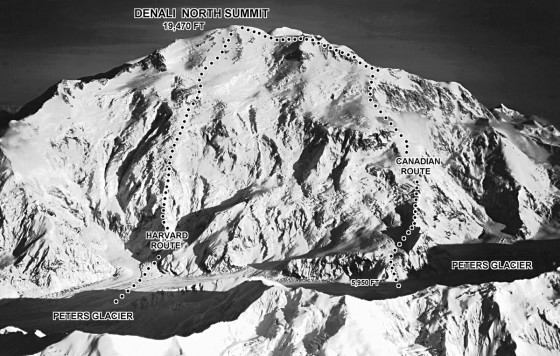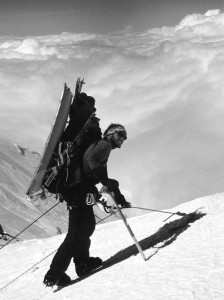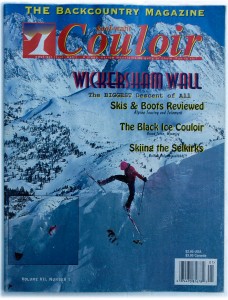1994: May 4-5, The adventure begins…
A storm kept our photographer Bill Stevenson, John, and I from departing on May fourth, but we hit a good send-off party with halibut, moose, and beer instead. We finalized gear the next morning, and taxied across the runway in John’s sleek white ’76 Caddy. Motivation was high. Talkeetna Air Taxi Paul flew us up the glacier to Kahiltna Airstrip and we began slogging across the glacier by 4:30 p.m.
This timing initiated a trend, and we never again made a start before noon. In fact, 3 p.m. was typical, especially on the Wickersham, where evening sun lasts until after midnight. Swing shift kept us warmer and enabled us to ski in beautiful, soft light.
May 6-10, Days II-VI of the approach
The second day found us in a whiteout, debating whether to double or single-carry, or stay put. The trail was well wanded for the 2,000 feet between the northeast fork of the Kahiltna and the base of the pass, so we elected to move the entire load at once, a fateful decision for Bill. Packs weighed 40 pounds, sleds another 80, and after four days, he developed internal bleeding, presumably from the strain. John and I carried a load up while Bill waited behind to consult medical types from other parties.
Our route diverged from the standard Denali lines of ascent in that we had to cross the divide and descend 4,000 feet and five miles of the Peters Glacier to reach the Wickersham Wall. We chose to cross via the summit of 10,800′ Mt. Capps, as opposed to the more traditional Kahiltna Pass crossing, to limit avalanche danger by staying on a ridge. This also reduced the crevasse dangers which plagued Wyatt and others while descending the pass.
Returning from Mt. Capps for a second load, John and I carved our first turns on 45° rime ice for a memorable, if not relaxing, start. Then we crossed two buried crevasses and hit wind compacted fluff for 50 turns. It was a bit of an ego-stoker since the entire army of guided parties and others slogging up the Kahiltna could view our serpentine signatures.Back at our camp, Bill informed us of the unfortunate fact that his urine had more blood in it, the condition was more painful, and he would have to bow out. It seemed like an incredible shame—so much planning and organization and he wouldn’t even get to see the Wickersham Wall. But time was short for John and me to get over to the upper Peters Basin; we couldn’t linger over heartfelt good-byes. Climbing Capps again we consolidated our cache into one haulbag, two gallon jugs of fuel, and two mega-packs.
Twenty feet down from the top I dropped into a crevasse. Wedged between ice and pack, barely able to breathe, my feet flailed in the black unknown for a purchase. John had me on belay and was on top of the situation, but I wasn’t entirely confident I wouldn’t slip further into the abyss.
After he had hauled me out, John fixed the first line across the 45° slope between us and Mt. Capps’ north rib, our safe avenue to the Peters Glacier, 2,800 feet below. We double–carried three ropelengths before reaching the ridge crest, where it was low–angled enough to travel roped with the haul pig between us. As both the sun and our energy levels sank, we decided to lower our 250 pounds of gear from ice screws and pickets.
As we worked our way down the rock–solid ice we couldn’t help wondering if this was the surface we’d find on the Wickersham? For now, however, our attention was focused on survival. Our energy was gone, we were dehydrated, and the Peters Glacier was still 1500 feet away. Clouds were gathering to the west and the barometer foretold storm. We either had to bivy or find a camp.
Desperation had nearly set in before I spotted our campsite, a filled–in bergschrund, the fattest and softest snow we’d seen. With new–found reserves of strength, John fashioned a platform and secured the tent with skis, crampons, axes, and pickets, then we struggled out of our gear and racked tough at 4 a.m. Sixty hours of storm gave us ample rest from that epic day, and when it pushed out we had a dramatic .028 rise in barometric pressure.
© 1994
This is a reprint of an article that was first published in Couloir VII-1, Oct/Nov 1994.
Related Posts
Wickersham Wall – Pt. I
Wickerham Wall – Pt. II
Wickerham Wall – Pt. III
Wickersham Wall – Pt. IV
Wickersham Wall – Pt. V




4 pings
[…] Posts Wickersham Wall – Pt. I Wickerham Wall – Pt. II Wickerham Wall – Pt. III Wickersham Wall – Pt. IV Wickersham Wall – Pt. V […]
[…] Couloir VII-1, Oct/Nov '94Related Posts Wickersham Wall – Pt. I Wickerham Wall – Pt. II Wickerham Wall – Pt. III Wickersham Wall – Pt. IV Wickersham Wall – Pt. V […]
[…] Posts Wickersham Wall – Pt. I Wickerham Wall – Pt. II Wickerham Wall – Pt. III Wickersham Wall – Pt. IV Wickersham Wall – Pt. V […]
[…] Posts Wickersham Wall – Pt. I Wickerham Wall – Pt. II Wickerham Wall – Pt. III Wickersham Wall – Pt. IV Wickersham Wall – Pt. V […]